Answered step by step
Verified Expert Solution
Question
1 Approved Answer
Reading Part: Questions: Did Babe Ruth Have a Comparative Advantage as a Pitcher? Edward M. Scahill The game of baseball can be used to illustrate
Reading Part: 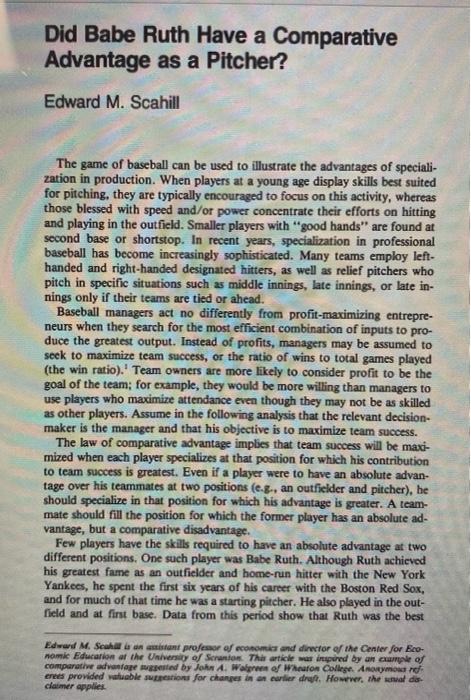
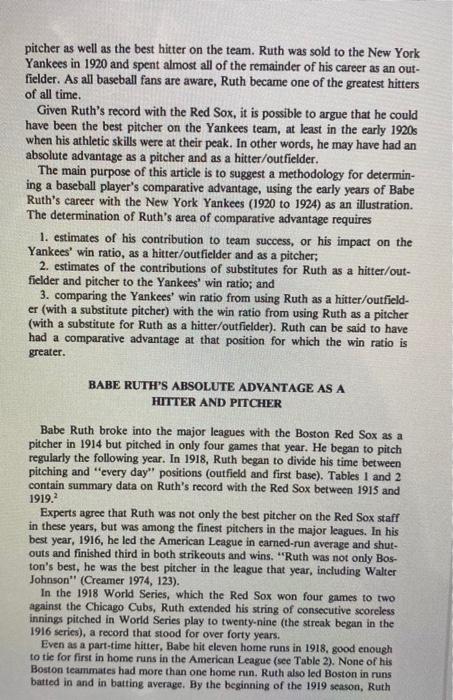
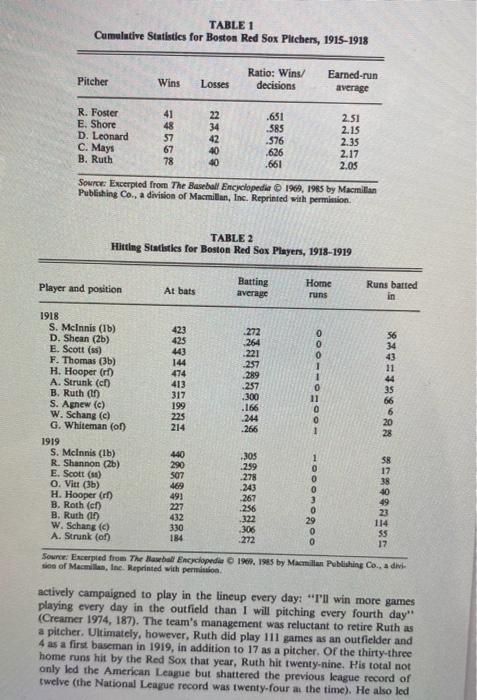
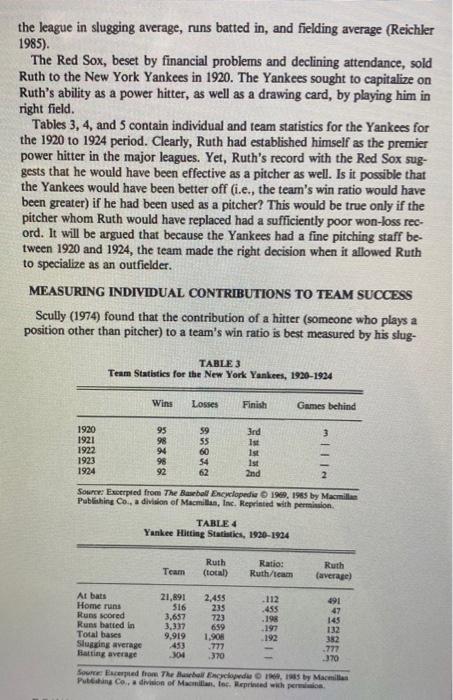
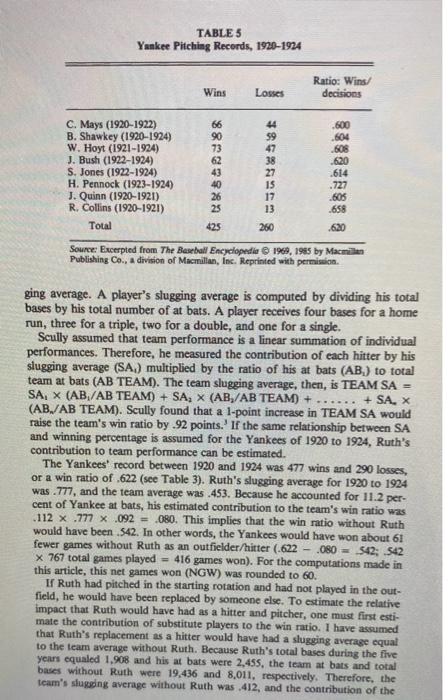
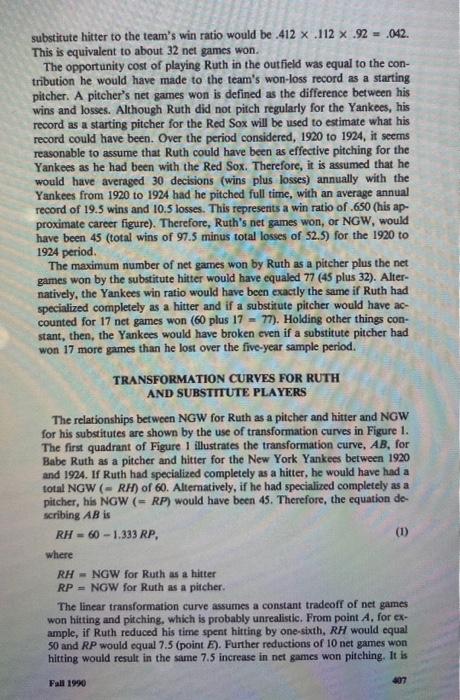
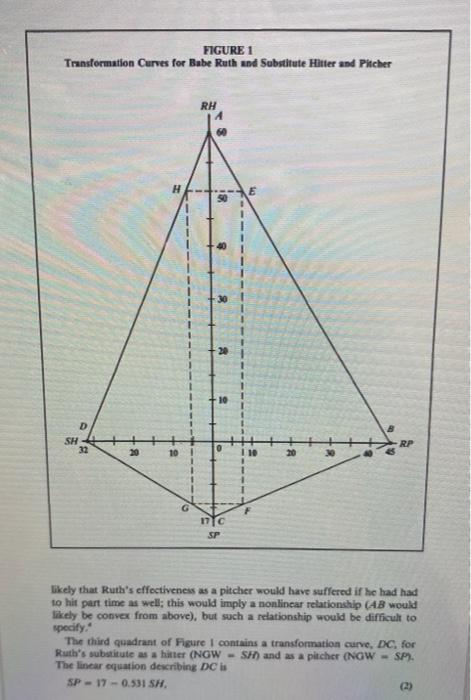
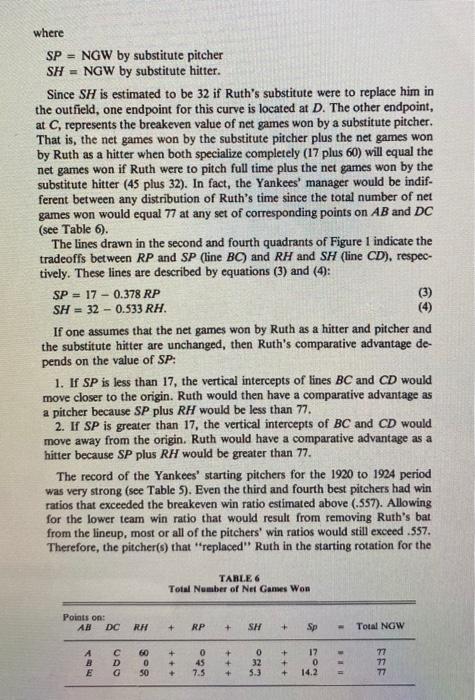
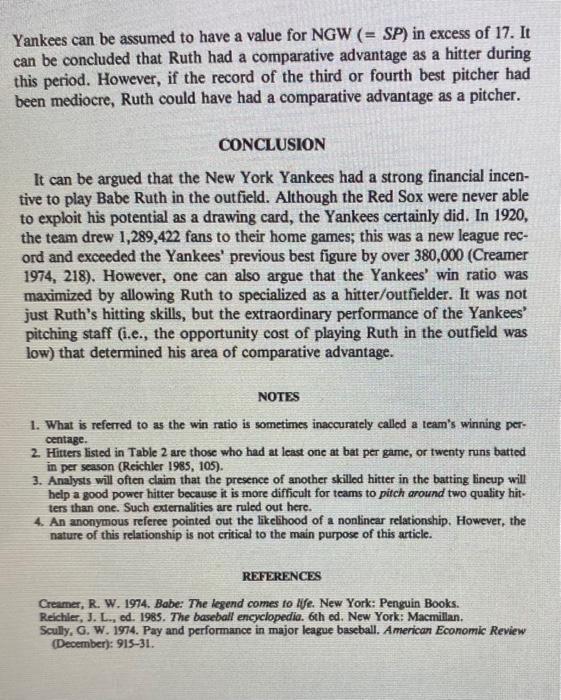
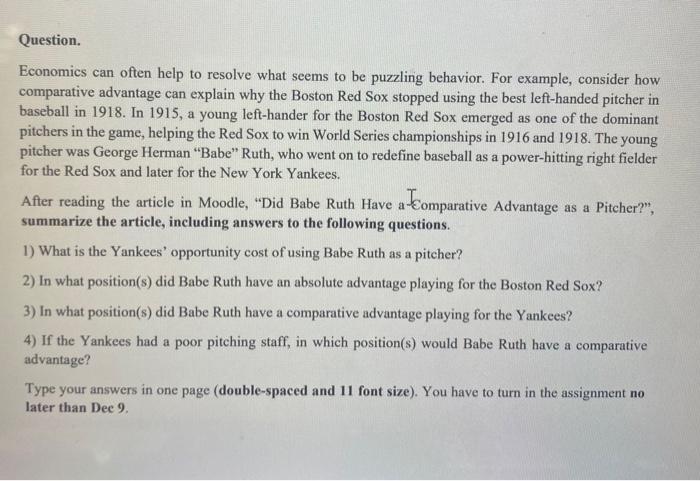
Did Babe Ruth Have a Comparative Advantage as a Pitcher? Edward M. Scahill The game of baseball can be used to illustrate the advantages of specialization in production. When players at a young age display skills best suited for pitching, they are typically encouraged to focus on this activity, whereas those blessed with speed and/or power concentrate their efforts on hitting and playing in the outfield. Smaller players with "good hands" are found at second base or shortstop. In recent years, specialization in professional baseball has become increasingly sophisticated. Many teams employ lefthanded and right-handed designated hitters, as well as relief pitchers who pitch in specific situations such as middle innings, late innings, or late innings only if their teams are tied or ahead. Baseball managers act no differently from profit-maximizing entrepreneurs when they search for the most efficient combination of inputs to produce the greatest output. Instead of profits, managers may be assumed to seek to maximize team success, or the ratio of wins to total games played (the win ratio). ' Team owners are more likely to consider profit to be the goal of the team; for example, they would be more willing than managers to use players who maximine attendance even though they may not be as skilled as other players. Assume in the following analysis that the relevant decisionmaker is the manager and that his objective is to maximize team success. The law of comparative advantage implies that team success will be maximized when each player specializes at that position for which his contribution to team success is greatest. Even if a player were to have an absolute advantage over his teammates at two positions (e.g., an outfielder and pircher), be should specialize in that position for which his advantage is greater. A teammate should fill the position for which the former player has an absolute advantage, but a comparative disadvantage. Few players have the skills required to have an absolute advantage at two different positions, One such player was Babe Ruth. Although Ruth achieved his greatest fame as an outfielder and home-run hitter with the New York Yankees, he spent the first six years of his career with the Boston Red Sox, and for much of that time he was a starting pitcher. He also played in the outfield and at first base. Data from this period show that Ruth was the best claimer applies. pitcher as well as the best hitter on the team. Ruth was sold to the New York Yankees in 1920 and spent almost all of the remainder of his career as an outfielder. As all baseball fans are aware, Ruth became one of the greatest hitters of all time. Given Ruth's record with the Red Sox, it is possible to argue that he could have been the best pitcher on the Yankees team, at least in the early 1920s when his athletic skills were at their peak. In other words, he may have had an absolute advantage as a pitcher and as a hitter/outfielder. The main purpose of this article is to suggest a methodology for determining a baseball player's comparative advantage, using the early years of Babe Ruth's career with the New York Yankees (1920 to 1924) as an illustration. The determination of Ruth's area of comparative advantage requires 1. estimates of his contribution to team success, or his impact on the Yankees' win ratio, as a hitter/outfielder and as a pitcher; 2. estimates of the contributions of substitutes for Ruth as a hitter/outfielder and pitcher to the Yankees' win ratio; and 3. comparing the Yankees' win ratio from using Ruth as a hitter/outfielder (with a substitute pitcher) with the win ratio from using Ruth as a pitcher (with a substitute for Ruth as a hitter/outfielder). Ruth can be said to have had a comparative advantage at that position for which the win ratio is greater. BABE RUTH'S ABSOLUTE ADVANTAGE AS A HITTER AND PITCHER Babe Ruth broke into the major leagues with the Boston Red Sox as a pitcher in 1914 but pitched in only four games that year. He began to pitch regularly the following year. In 1918, Ruth began to divide his time between pitching and "every day" positions (outfield and first base). Tables 1 and 2 contain summary data on Ruth's record with the Red Sox between 1915 and 1919. 2 Experts agree that Ruth was not only the best pitcher on the Red Sox staff in these years, but was among the finest pitchers in the major leagues. In his best year, 1916, he led the American League in earned-run average and shutouts and finished third in both strikeouts and wins. "TRuth was not only Boston's best, he was the best pitcher in the league that year, including Walter Johnson" (Creamer 1974, 123). In the 1918 World Series, which the Red Sox won four games to two against the Chicago Cubs, Ruth extended his string of consecutive scoreless innings pitched in World Series play to twenty-nine (the streak began in the 1916 series), a record that stood for over forty years. Even as a part-time hitter, Babe hit eleven home runs in 1918, good enough to tic for first in home runs in the American League (see Table 2). None of his Boston teammates had more than one home nun. Ruth also led Boston in runs batted in and in batting average. By the beginning of the 1919 season, Ruth TABLE 1 Cumalative Statistics for Boston Red Sox Pitchers, 1915-1918 Source Euserpted frocn The Basebaly Encyclopedia (1) 1969, 1985 by Macmillan Publiating Co.r, a divisioa of Macrillan, Inc. Reprinted with perminion. TABLE 2 Hitting Statbries for Boston Red Sox Players, 1918-1919 tioe of Macmilin, ine. Rleprinted with permintion. actively campaigned to play in the lineup every day: "I'll win more games playing every day in the outfield than I will pitching every fourth day" (Creamer 1974, 187). The team's management was reluctant to retire Ruth as: a pitcher. Ultimately, however, Ruth did play 111 games as an outfielder and 4 as a first basernan in 1919 , in addition to 17 as a pitcher. Of the thirty-three home runs hit by the Red Sox that year, Ruth hit twenty-nine. His total not only led the American League but shattered the previous league record of twelve (the National League record was twenty-four an the time). He also led the league in slugging average, nuns batted in, and fielding average (Reichler 1985). The Red Sox, beset by financial problems and declining attendance, sold Ruth to the New York Yankees in 1920. The Yankees sought to capitalize on Ruth's ability as a power hitter, as well as a drawing card, by playing him in right field. Tables 3, 4, and 5 contain individual and team statistics for the Yankees for the 1920 to 1924 period. Clearly, Ruth had established himself as the premier power hitter in the major leagues. Yet, Ruth's record with the Red Sox suggests that he would have been effective as a pitcher as well. Is it possible that the Yankees would have been better off (i.e., the team's win ratio would have been greater) if he had been used as a pitcher? This would be true only if the pitcher whom Ruth would have replaced had a sufficiently poor won-loss record. It will be argued that because the Yankees had a fine pitching staff between 1920 and 1924, the team made the right decision when it allowed Ruth to specialize as an outfielder. MEASURING INDIVIDUAL CONTRIBUTIONS TO TEAM SUCCESS Scully (1974) found that the contribution of a hitter (someone who plays a position other than pitcher) to a team's win ratio is best measured by his slug- TABLE 3 Team Statbtics for the New York Yankees, 1920-1924 Sounce: Exorrpied from The Basebol Encyclopedia 91969,1955 by Macmillaz Publithing Co, a dividion of Macmillas, Inc, Reprinted with perrainion. source: Eucerpted from The Beseball Encyelopendat (3 1969, 1955 by Macmilin Publishing Co., a division of Macmillan, Inc. Reprinted with permismica. ging average. A player's slugging average is computed by dividing his total bases by his total number of at bats. A player receives four bases for a home run, three for a triple, two for a double, and one for a single. Scully assumed that team performance is a linear summation of individual performances. Therefore, he measured the contribution of each hitter by his slugging average (SA1) multiplied by the ratio of his at bats (AB2) to total team at bats (AB TEAM). The team slugging average, then, is TEAM SA = SA1(AB/ABTEAM)+SA(AB/ABTBAM)++AA (ABN/AB TEAM). Scully found that a 1-point increase in TEAM SA would raise the team's win ratio by .92 points. 3 If the same relationship between SA and winning percentage is assumed for the Yankees of 1920 to 1924, Ruth's contribution to team performance can be estimated. The Yankees' record between 1920 and 1924 was 477 wins and 290 losses, or a win ratio of, 622 (see Table 3). Ruth's slugging average for 1920 to 1924 was .777, and the team average was .453. Because he accounted for 11.2 percent of Yankee at bats, his estimated contribution to the team's win ratio wrs .112.777.092=.090. This implies that the win ratio without Ruth would have been .542. In other words, the Yankees would have won about 6 I fewer games without Ruth as an outfielder/hitter (.622.080=$42 : 542 767 total games played =416 games won). For the computations made in this article, this net games won (NGW) was rounded to 60 . If Ruth had pitched in the starting rotation and had not played in the outfield, he would have been replaced by someone else. To estimate the relative impact that Ruth would have had as a hitter and pitcher, one must first estimate the contribution of substitute players to the win ratio. I have assumed that Ruth's replacement as a hitter would have had a slugging average equal to the tearn average without Ruth. Because Ruth's total bases during the five years equaled 1,908 and his at bats were 2,455, the team at bats and total bases without Ruth were 19,436 and 8,011 , respectively, Therefore, the substitute hitter to the team's win ratio would be .412.112.92=.042. This is equivalent to about 32 net games won. The opportunity cost of playing Ruth in the outfield was equal to the contribution he would have made to the team's won-loss record as a starting pitcher. A pitcher's net games won is defined as the difference between his wins and losses. Although Ruth did not pitch regularly for the Yankees, his record as a starting pitcher for the Red Sox will be used to estimate what his record could have been. Over the period considered, 1920 to 1924 , it seems reasonable to assume that Ruth could have been as effective pitching for the Yankees as he had been with the Red Sox. Therefore, it is assumed that he would have averaged 30 decisions (wins plus losses) annually with the Yankees from 1920 to 1924 had he pitched full time, with an average annual record of 19.5 wins and 10.5 losses. This represents a win ratio of . 650 (his approximate career figure). Therefore, Ruth's net games won, or NGW, would have been 45 (total wins of 97.5 minus total losses of 52.5 ) for the 1920 to 1924 period. The maximum number of net games won by Ruth as a pitcher plus the net games won by the substitute hitter would have equaled 77 (45 plus 32). Alternatively, the Yankees win ratio would have been exactly the same if Ruth had specialized completely as a hitter and if a substitute pitcher would have accounted for 17 net games won ( 60 plus 17=77 ). Holding other things constant, then, the Yankees would have broken even if a substitute pitcher had won 17 more games than he lost over the five-year sample period. TRANSFORMATION CURVES FOR RUTH AND SUBSTITUTE PLAYERS The relationships between NGW for Ruth as a pitcher and hitter and NGW for his substitutes are shown by the use of transformation curves in Figure 1 . The first quadrant of Figure 1 illustrates the transformation curve, AB, for Babe Ruth as a pitcher and hitter for the New York Yankees between 1920 and 1924. If Ruth had specialized completely as a hitter, he would have had a total NGW (=RH) of 60 . Altematively, if he had specialized completely as a pitcher, his NGW (=RP) would have been 45 . Therefore, the equation doscribing AB is RH=601.333RP, where RH= NGW for Ruth as a hitter RP= NGW for Ruth as a pitcher. The linear transformation curve assumes a constant tradeoff of net games won hitting and pitching, which is probably unrealistic. From point A, for ex ample, if Ruth reduced his time spent hitting by one-sixth, RH would equal 50 and RP would equal 7.5 (point E ). Further reductions of 10 net games won hitting would result in the same 7.5 increase in net games won pitching. It is Fall 19%0 497 FIGURE 1 likely that Ruth's effectiveness as a pitcher would have suffered if he had had to hit part time as well; this would imply a nonlinear relationshlp (AB would likely be convex from above), but such a retationship would be difficult to specify," The third guadrant of Figure I contains a transformation curve, DC, for Rutb's substitute as a hitter (NOW=SH) and as a pitcher (NOW=SP9. The linear equation dexcribing DC is SP=170.531sH. where SP= NGW by substitute pitcher SH = NGW by substitute hitter. Since SH is estimated to be 32 if Ruth's substitute were to replace him in the outfield, one endpoint for this curve is located at D. The other endpoint, at C, represents the breakeven value of net games won by a substitute pitcher. That is, the net games won by the substitute pitcher plus the net games won by Ruth as a hitter when both specialize completely ( 17 plus 60 ) will equal the net games won if Ruth were to pitch full time plus the net games won by the substitute hitter ( 45 plus 32). In fact, the Yankees' manager would be indifferent between any distribution of Ruth's time since the total number of net games won would equal 77 at any set of corresponding points on AB and DC (see Table 6). The lines drawn in the second and fourth quadrants of Figure 1 indicate the tradeoffs between RP and SP (line BC ) and RH and SH (line CD ), respectively. These lines are described by equations (3) and (4): SP=170.378RPSH=320.533RH. If one assumes that the net games won by Ruth as a hitter and pitcher and the substitute hitter are unchanged, then Ruth's comparative advantage depends on the value of SP : 1. If SP is less than 17 , the vertical intercepts of lines BC and CD would move closer to the origin. Ruth would then have a comparative advantage as a pitcher because SP plus RH would be less than 77. 2. If SP is greater than 17 , the vertical intercepts of BC and CD would move away from the origin. Ruth would have a comparative advantage as a hitter because SP plus RH would be greater than 77. The record of the Yankees' starting pitchers for the 1920 to 1924 period was very strong (see Table 5). Even the third and fourth best pitchers had win ratios that exceeded the breakeven win ratio estimated above (.557). Allowing for the lower team win ratio that would result from removing Ruth's bat from the lineup, most or all of the pitchers' win ratios would still exceed . 557. Therefore, the pitcher(s) that "replaced" Ruth in the starting rotation for the Yankees can be assumed to have a value for NGW (=SP) in excess of 17. It can be concluded that Ruth had a comparative advantage as a hitter during this period. However, if the record of the third or fourth best pitcher had been mediocre, Ruth could have had a comparative advantage as a pitcher. OONCLUSION It can be argued that the New York Yankees had a strong financial incentive to play Babe Ruth in the outfield. Although the Red Sox were never able to exploit his potential as a drawing card, the Yankees certainly did. In 1920, the team drew 1,289,422 fans to their home games; this was a new league record and exceeded the Yankees' previous best figure by over 380,000 (Creamer 1974, 218). However, one can also argue that the Yankees' win ratio was maximized by allowing Ruth to specialized as a hitter/outfielder. It was not just Ruth's hitting skills, but the extraordinary performance of the Yankees' pitching staff (i.e., the opportunity cost of playing Ruth in the outfield was low) that determined his area of comparative advantage. NOTES 1. What is referred to as the win ratio is sometimes inaccurately called a team's winning percentage. 2. Fitters listed in Table 2 are those who had at least one at bat per game, or twenty runs batted in per season (Reichler 1985, 105). 3. Analysts will often claim that the presence of another skilled hitter in the batting lineup will help a good power hitter because it is more difficult for teams to pitch around two quality hitters than one. Such externalities are ruled out here. 4. An anonymous referee pointed out the likelihood of a nonlinear relationship. However, the nature of this relationship is not critical to the main purpose of this article. REFERENCES Creamer, R. W. 1974, Babe: The legend comes to IVe. New York: Penguin Books. Reichler, J. L., od. 1985. The baseball encyclopedia. 6th od. New York: Macmillan. Scully, G. W. 1974. Pay and performance in major league baseball. American Economic Review (December): 915-31. Economics can often help to resolve what seems to be puzzling behavior. For example, consider how comparative advantage can explain why the Boston Red Sox stopped using the best left-handed pitcher in baseball in 1918. In 1915, a young left-hander for the Boston Red Sox emerged as one of the dominant pitchers in the game, helping the Red Sox to win World Series championships in 1916 and 1918. The young pitcher was George Herman "Babe" Ruth, who went on to redefine baseball as a power-hitting right fielder for the Red Sox and later for the New York Yankees. After reading the article in Moodle, "Did Babe Ruth Have a Comparative Advantage as a Pitcher?", summarize the article, including answers to the following questions. 1) What is the Yankees' opportunity cost of using Babe Ruth as a pitcher? 2) In what position(s) did Babe Ruth have an absolute advantage playing for the Boston Red Sox? 3) In what position(s) did Babe Ruth have a comparative advantage playing for the Yankees? 4) If the Yankees had a poor pitching staff, in which position(s) would Babe Ruth have a comparative advantage? Type your answers in one page (double-spaced and 11 font size). You have to turn in the assignment no later than Dee 9. Did Babe Ruth Have a Comparative Advantage as a Pitcher? Edward M. Scahill The game of baseball can be used to illustrate the advantages of specialization in production. When players at a young age display skills best suited for pitching, they are typically encouraged to focus on this activity, whereas those blessed with speed and/or power concentrate their efforts on hitting and playing in the outfield. Smaller players with "good hands" are found at second base or shortstop. In recent years, specialization in professional baseball has become increasingly sophisticated. Many teams employ lefthanded and right-handed designated hitters, as well as relief pitchers who pitch in specific situations such as middle innings, late innings, or late innings only if their teams are tied or ahead. Baseball managers act no differently from profit-maximizing entrepreneurs when they search for the most efficient combination of inputs to produce the greatest output. Instead of profits, managers may be assumed to seek to maximize team success, or the ratio of wins to total games played (the win ratio). ' Team owners are more likely to consider profit to be the goal of the team; for example, they would be more willing than managers to use players who maximine attendance even though they may not be as skilled as other players. Assume in the following analysis that the relevant decisionmaker is the manager and that his objective is to maximize team success. The law of comparative advantage implies that team success will be maximized when each player specializes at that position for which his contribution to team success is greatest. Even if a player were to have an absolute advantage over his teammates at two positions (e.g., an outfielder and pircher), be should specialize in that position for which his advantage is greater. A teammate should fill the position for which the former player has an absolute advantage, but a comparative disadvantage. Few players have the skills required to have an absolute advantage at two different positions, One such player was Babe Ruth. Although Ruth achieved his greatest fame as an outfielder and home-run hitter with the New York Yankees, he spent the first six years of his career with the Boston Red Sox, and for much of that time he was a starting pitcher. He also played in the outfield and at first base. Data from this period show that Ruth was the best claimer applies. pitcher as well as the best hitter on the team. Ruth was sold to the New York Yankees in 1920 and spent almost all of the remainder of his career as an outfielder. As all baseball fans are aware, Ruth became one of the greatest hitters of all time. Given Ruth's record with the Red Sox, it is possible to argue that he could have been the best pitcher on the Yankees team, at least in the early 1920s when his athletic skills were at their peak. In other words, he may have had an absolute advantage as a pitcher and as a hitter/outfielder. The main purpose of this article is to suggest a methodology for determining a baseball player's comparative advantage, using the early years of Babe Ruth's career with the New York Yankees (1920 to 1924) as an illustration. The determination of Ruth's area of comparative advantage requires 1. estimates of his contribution to team success, or his impact on the Yankees' win ratio, as a hitter/outfielder and as a pitcher; 2. estimates of the contributions of substitutes for Ruth as a hitter/outfielder and pitcher to the Yankees' win ratio; and 3. comparing the Yankees' win ratio from using Ruth as a hitter/outfielder (with a substitute pitcher) with the win ratio from using Ruth as a pitcher (with a substitute for Ruth as a hitter/outfielder). Ruth can be said to have had a comparative advantage at that position for which the win ratio is greater. BABE RUTH'S ABSOLUTE ADVANTAGE AS A HITTER AND PITCHER Babe Ruth broke into the major leagues with the Boston Red Sox as a pitcher in 1914 but pitched in only four games that year. He began to pitch regularly the following year. In 1918, Ruth began to divide his time between pitching and "every day" positions (outfield and first base). Tables 1 and 2 contain summary data on Ruth's record with the Red Sox between 1915 and 1919. 2 Experts agree that Ruth was not only the best pitcher on the Red Sox staff in these years, but was among the finest pitchers in the major leagues. In his best year, 1916, he led the American League in earned-run average and shutouts and finished third in both strikeouts and wins. "TRuth was not only Boston's best, he was the best pitcher in the league that year, including Walter Johnson" (Creamer 1974, 123). In the 1918 World Series, which the Red Sox won four games to two against the Chicago Cubs, Ruth extended his string of consecutive scoreless innings pitched in World Series play to twenty-nine (the streak began in the 1916 series), a record that stood for over forty years. Even as a part-time hitter, Babe hit eleven home runs in 1918, good enough to tic for first in home runs in the American League (see Table 2). None of his Boston teammates had more than one home nun. Ruth also led Boston in runs batted in and in batting average. By the beginning of the 1919 season, Ruth TABLE 1 Cumalative Statistics for Boston Red Sox Pitchers, 1915-1918 Source Euserpted frocn The Basebaly Encyclopedia (1) 1969, 1985 by Macmillan Publiating Co.r, a divisioa of Macrillan, Inc. Reprinted with perminion. TABLE 2 Hitting Statbries for Boston Red Sox Players, 1918-1919 tioe of Macmilin, ine. Rleprinted with permintion. actively campaigned to play in the lineup every day: "I'll win more games playing every day in the outfield than I will pitching every fourth day" (Creamer 1974, 187). The team's management was reluctant to retire Ruth as: a pitcher. Ultimately, however, Ruth did play 111 games as an outfielder and 4 as a first basernan in 1919 , in addition to 17 as a pitcher. Of the thirty-three home runs hit by the Red Sox that year, Ruth hit twenty-nine. His total not only led the American League but shattered the previous league record of twelve (the National League record was twenty-four an the time). He also led the league in slugging average, nuns batted in, and fielding average (Reichler 1985). The Red Sox, beset by financial problems and declining attendance, sold Ruth to the New York Yankees in 1920. The Yankees sought to capitalize on Ruth's ability as a power hitter, as well as a drawing card, by playing him in right field. Tables 3, 4, and 5 contain individual and team statistics for the Yankees for the 1920 to 1924 period. Clearly, Ruth had established himself as the premier power hitter in the major leagues. Yet, Ruth's record with the Red Sox suggests that he would have been effective as a pitcher as well. Is it possible that the Yankees would have been better off (i.e., the team's win ratio would have been greater) if he had been used as a pitcher? This would be true only if the pitcher whom Ruth would have replaced had a sufficiently poor won-loss record. It will be argued that because the Yankees had a fine pitching staff between 1920 and 1924, the team made the right decision when it allowed Ruth to specialize as an outfielder. MEASURING INDIVIDUAL CONTRIBUTIONS TO TEAM SUCCESS Scully (1974) found that the contribution of a hitter (someone who plays a position other than pitcher) to a team's win ratio is best measured by his slug- TABLE 3 Team Statbtics for the New York Yankees, 1920-1924 Sounce: Exorrpied from The Basebol Encyclopedia 91969,1955 by Macmillaz Publithing Co, a dividion of Macmillas, Inc, Reprinted with perrainion. source: Eucerpted from The Beseball Encyelopendat (3 1969, 1955 by Macmilin Publishing Co., a division of Macmillan, Inc. Reprinted with permismica. ging average. A player's slugging average is computed by dividing his total bases by his total number of at bats. A player receives four bases for a home run, three for a triple, two for a double, and one for a single. Scully assumed that team performance is a linear summation of individual performances. Therefore, he measured the contribution of each hitter by his slugging average (SA1) multiplied by the ratio of his at bats (AB2) to total team at bats (AB TEAM). The team slugging average, then, is TEAM SA = SA1(AB/ABTEAM)+SA(AB/ABTBAM)++AA (ABN/AB TEAM). Scully found that a 1-point increase in TEAM SA would raise the team's win ratio by .92 points. 3 If the same relationship between SA and winning percentage is assumed for the Yankees of 1920 to 1924, Ruth's contribution to team performance can be estimated. The Yankees' record between 1920 and 1924 was 477 wins and 290 losses, or a win ratio of, 622 (see Table 3). Ruth's slugging average for 1920 to 1924 was .777, and the team average was .453. Because he accounted for 11.2 percent of Yankee at bats, his estimated contribution to the team's win ratio wrs .112.777.092=.090. This implies that the win ratio without Ruth would have been .542. In other words, the Yankees would have won about 6 I fewer games without Ruth as an outfielder/hitter (.622.080=$42 : 542 767 total games played =416 games won). For the computations made in this article, this net games won (NGW) was rounded to 60 . If Ruth had pitched in the starting rotation and had not played in the outfield, he would have been replaced by someone else. To estimate the relative impact that Ruth would have had as a hitter and pitcher, one must first estimate the contribution of substitute players to the win ratio. I have assumed that Ruth's replacement as a hitter would have had a slugging average equal to the tearn average without Ruth. Because Ruth's total bases during the five years equaled 1,908 and his at bats were 2,455, the team at bats and total bases without Ruth were 19,436 and 8,011 , respectively, Therefore, the substitute hitter to the team's win ratio would be .412.112.92=.042. This is equivalent to about 32 net games won. The opportunity cost of playing Ruth in the outfield was equal to the contribution he would have made to the team's won-loss record as a starting pitcher. A pitcher's net games won is defined as the difference between his wins and losses. Although Ruth did not pitch regularly for the Yankees, his record as a starting pitcher for the Red Sox will be used to estimate what his record could have been. Over the period considered, 1920 to 1924 , it seems reasonable to assume that Ruth could have been as effective pitching for the Yankees as he had been with the Red Sox. Therefore, it is assumed that he would have averaged 30 decisions (wins plus losses) annually with the Yankees from 1920 to 1924 had he pitched full time, with an average annual record of 19.5 wins and 10.5 losses. This represents a win ratio of . 650 (his approximate career figure). Therefore, Ruth's net games won, or NGW, would have been 45 (total wins of 97.5 minus total losses of 52.5 ) for the 1920 to 1924 period. The maximum number of net games won by Ruth as a pitcher plus the net games won by the substitute hitter would have equaled 77 (45 plus 32). Alternatively, the Yankees win ratio would have been exactly the same if Ruth had specialized completely as a hitter and if a substitute pitcher would have accounted for 17 net games won ( 60 plus 17=77 ). Holding other things constant, then, the Yankees would have broken even if a substitute pitcher had won 17 more games than he lost over the five-year sample period. TRANSFORMATION CURVES FOR RUTH AND SUBSTITUTE PLAYERS The relationships between NGW for Ruth as a pitcher and hitter and NGW for his substitutes are shown by the use of transformation curves in Figure 1 . The first quadrant of Figure 1 illustrates the transformation curve, AB, for Babe Ruth as a pitcher and hitter for the New York Yankees between 1920 and 1924. If Ruth had specialized completely as a hitter, he would have had a total NGW (=RH) of 60 . Altematively, if he had specialized completely as a pitcher, his NGW (=RP) would have been 45 . Therefore, the equation doscribing AB is RH=601.333RP, where RH= NGW for Ruth as a hitter RP= NGW for Ruth as a pitcher. The linear transformation curve assumes a constant tradeoff of net games won hitting and pitching, which is probably unrealistic. From point A, for ex ample, if Ruth reduced his time spent hitting by one-sixth, RH would equal 50 and RP would equal 7.5 (point E ). Further reductions of 10 net games won hitting would result in the same 7.5 increase in net games won pitching. It is Fall 19%0 497 FIGURE 1 likely that Ruth's effectiveness as a pitcher would have suffered if he had had to hit part time as well; this would imply a nonlinear relationshlp (AB would likely be convex from above), but such a retationship would be difficult to specify," The third guadrant of Figure I contains a transformation curve, DC, for Rutb's substitute as a hitter (NOW=SH) and as a pitcher (NOW=SP9. The linear equation dexcribing DC is SP=170.531sH. where SP= NGW by substitute pitcher SH = NGW by substitute hitter. Since SH is estimated to be 32 if Ruth's substitute were to replace him in the outfield, one endpoint for this curve is located at D. The other endpoint, at C, represents the breakeven value of net games won by a substitute pitcher. That is, the net games won by the substitute pitcher plus the net games won by Ruth as a hitter when both specialize completely ( 17 plus 60 ) will equal the net games won if Ruth were to pitch full time plus the net games won by the substitute hitter ( 45 plus 32). In fact, the Yankees' manager would be indifferent between any distribution of Ruth's time since the total number of net games won would equal 77 at any set of corresponding points on AB and DC (see Table 6). The lines drawn in the second and fourth quadrants of Figure 1 indicate the tradeoffs between RP and SP (line BC ) and RH and SH (line CD ), respectively. These lines are described by equations (3) and (4): SP=170.378RPSH=320.533RH. If one assumes that the net games won by Ruth as a hitter and pitcher and the substitute hitter are unchanged, then Ruth's comparative advantage depends on the value of SP : 1. If SP is less than 17 , the vertical intercepts of lines BC and CD would move closer to the origin. Ruth would then have a comparative advantage as a pitcher because SP plus RH would be less than 77. 2. If SP is greater than 17 , the vertical intercepts of BC and CD would move away from the origin. Ruth would have a comparative advantage as a hitter because SP plus RH would be greater than 77. The record of the Yankees' starting pitchers for the 1920 to 1924 period was very strong (see Table 5). Even the third and fourth best pitchers had win ratios that exceeded the breakeven win ratio estimated above (.557). Allowing for the lower team win ratio that would result from removing Ruth's bat from the lineup, most or all of the pitchers' win ratios would still exceed . 557. Therefore, the pitcher(s) that "replaced" Ruth in the starting rotation for the Yankees can be assumed to have a value for NGW (=SP) in excess of 17. It can be concluded that Ruth had a comparative advantage as a hitter during this period. However, if the record of the third or fourth best pitcher had been mediocre, Ruth could have had a comparative advantage as a pitcher. OONCLUSION It can be argued that the New York Yankees had a strong financial incentive to play Babe Ruth in the outfield. Although the Red Sox were never able to exploit his potential as a drawing card, the Yankees certainly did. In 1920, the team drew 1,289,422 fans to their home games; this was a new league record and exceeded the Yankees' previous best figure by over 380,000 (Creamer 1974, 218). However, one can also argue that the Yankees' win ratio was maximized by allowing Ruth to specialized as a hitter/outfielder. It was not just Ruth's hitting skills, but the extraordinary performance of the Yankees' pitching staff (i.e., the opportunity cost of playing Ruth in the outfield was low) that determined his area of comparative advantage. NOTES 1. What is referred to as the win ratio is sometimes inaccurately called a team's winning percentage. 2. Fitters listed in Table 2 are those who had at least one at bat per game, or twenty runs batted in per season (Reichler 1985, 105). 3. Analysts will often claim that the presence of another skilled hitter in the batting lineup will help a good power hitter because it is more difficult for teams to pitch around two quality hitters than one. Such externalities are ruled out here. 4. An anonymous referee pointed out the likelihood of a nonlinear relationship. However, the nature of this relationship is not critical to the main purpose of this article. REFERENCES Creamer, R. W. 1974, Babe: The legend comes to IVe. New York: Penguin Books. Reichler, J. L., od. 1985. The baseball encyclopedia. 6th od. New York: Macmillan. Scully, G. W. 1974. Pay and performance in major league baseball. American Economic Review (December): 915-31. Economics can often help to resolve what seems to be puzzling behavior. For example, consider how comparative advantage can explain why the Boston Red Sox stopped using the best left-handed pitcher in baseball in 1918. In 1915, a young left-hander for the Boston Red Sox emerged as one of the dominant pitchers in the game, helping the Red Sox to win World Series championships in 1916 and 1918. The young pitcher was George Herman "Babe" Ruth, who went on to redefine baseball as a power-hitting right fielder for the Red Sox and later for the New York Yankees. After reading the article in Moodle, "Did Babe Ruth Have a Comparative Advantage as a Pitcher?", summarize the article, including answers to the following questions. 1) What is the Yankees' opportunity cost of using Babe Ruth as a pitcher? 2) In what position(s) did Babe Ruth have an absolute advantage playing for the Boston Red Sox? 3) In what position(s) did Babe Ruth have a comparative advantage playing for the Yankees? 4) If the Yankees had a poor pitching staff, in which position(s) would Babe Ruth have a comparative advantage? Type your answers in one page (double-spaced and 11 font size). You have to turn in the assignment no later than Dee 9 








Questions:

Step by Step Solution
There are 3 Steps involved in it
Step: 1

Get Instant Access to Expert-Tailored Solutions
See step-by-step solutions with expert insights and AI powered tools for academic success
Step: 2

Step: 3

Ace Your Homework with AI
Get the answers you need in no time with our AI-driven, step-by-step assistance
Get Started


